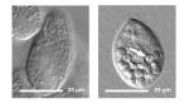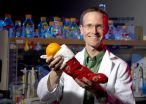(Press-News.org) (Santa Barbara, Calif.) –– An interdisciplinary team of researchers at UC Santa Barbara has produced a groundbreaking study of how nanoparticles are able to biomagnify in a simple microbial food chain.
"This was a simple scientific curiosity," said Patricia Holden, professor in UCSB's Bren School of Environmental Science & Management and the corresponding author of the study, published in an early online edition of the journal Nature Nanotechnology. "But it is also of great importance to this new field of looking at the interface of nanotechnology and the environment."
Holden's co-authors from UCSB include Eduardo Orias, research professor of genomics with the Department of Molecular, Cellular and Developmental Biology; Galen Stucky, professor of chemistry and biochemistry, and materials; and graduate students, postdoctoral scholars, and staff researchers Rebecca Werlin, Randy Mielke, John Priester, and Peter Stoimenov. Other co-authors are Stephan Krämer, from the California Nanosystems Institute, and Gary Cherr and Susan Jackson, from the UC Davis Bodega Marine Laboratory.
The research was partially funded by the U.S. Environmental Protection Agency (EPA) STAR Program, and by the UC Center for the Environmental Implications of Nanotechnology (UC CEIN), a $24 million collaboration based at UCLA, with researchers from UCSB, UC Davis, UC Riverside, Columbia University, and other national and international partners. UC CEIN is funded by the National Science Foundation and the EPA.
According to Holden, a prior collaboration with Stucky, Stoimenov, Priester, and Mielke provided the foundation for this research. In that earlier study, the researchers observed that nanoparticles formed from cadmium selenide were entering certain bacteria (called Pseudomonas) and accumulating in them. "We already knew that the bacteria were internalizing these nanoparticles from our previous study," Holden said. "And we also knew that Ed (Orias) and Rebecca (Werlin) were working with a protozoan called Tetrahymena and nanoparticles. So we approached them and asked if they would be interested in a collaboration to evaluate how the protozoan predator is affected by the accumulated nanoparticles inside a bacterial prey." Orias and Werlin credit their interest in nanoparticle toxicity to earlier funding from and participation in the University of California Toxic Substance Research & Training Program.
The scientists repeated the growth of the bacteria with quantum dots in the new study and and coupled it to a trophic transfer study –– the study of the transfer of a compound from a lower to a higher level in a food chain by predation. "We looked at the difference to the predator as it was growing at the expense of different prey types –– 'control' prey without any metals, prey that had been grown with a dissolved cadmium salt, and prey that had been grown with cadmium selenide quantum dots," Holden said.
What they found was that the concentration of cadmium increased in the transfer from bacteria to protozoa and, in the process of increasing concentration, the nanoparticles were substantially intact, with very little degradation. "We were able to measure the ratio of the cadmium to the selenium in particles that were inside the protozoa and see that it was substantially the same as in the original nanoparticles that had been used to feed the bacteria," Orias said.
The fact that the ratio of cadmium and selenide was preserved throughout the course of the study indicates that the nanoparticles were themselves biomagnified. "Biomagnification –– the increase in concentration of cadmium as the tracer for nanoparticles from prey into predator –– this is the first time this has been reported for nanomaterials in an aquatic environment, and furthermore involving microscopic life forms, which comprise the base of all food webs," Holden said.
An implication is that nanoparticles inside the protozoa could then be available to the next level of predators in the food chain, which could lead to broader ecological effects. "These protozoa are greatly enriched in nanoparticles because of feeding on quantum dot-laced bacteria," Hold said. "Because there were toxic effects on the protozoa in this study, there is a concern that there could also be toxic effects higher in the food chain, especially in aquatic environments."
One of the missions of UC CEIN is to try to understand the effects of nanomaterials in the environment, and how scientists can prevent any possible negative effects that might pose a threat to any form of life. "In this context, one might argue that if you could 'design out' whatever property of the quantum dots causes them to enter bacteria, then we could avoid this potential consequence," Holden said. "That would be a positive way of viewing a study like this. Now scientists can look back and say, 'How do we prevent this from happening?' "
INFORMATION:
UCSB scientists demonstrate biomagnification of nanomaterials in simple food chain
2010-12-21
ELSE PRESS RELEASES FROM THIS DATE:
New imaging advance illuminates immune response in breathing lung
2010-12-21
Fast-moving objects create blurry images in photography, and the same challenge exists when scientists observe cellular interactions within tissues constantly in motion, such as the breathing lung. In a recent UCSF-led study in mice, researchers developed a method to stabilize living lung tissue for imaging without disrupting the normal function of the organ. The method allowed the team to observe, for the first time, both the live interaction of living cells in the context of their environment and the unfolding of events in the immune response to lung injury.
The finding ...
Strange new twist: Berkeley researchers discover Möbius symmetry in metamaterials
2010-12-21
Möbius symmetry, the topological phenomenon that yields a
half-twisted strip with two surfaces but only one side, has been a source of fascination since its discovery in 1858 by German mathematician August Möbius. As artist M.C. Escher so vividly demonstrated in his "parade of ants," it is possible to traverse the "inside" and "outside" surfaces of a Möbius strip without crossing over an edge. For years, scientists have been searching for an example of Möbius symmetry in natural materials without any success. Now a team of scientists has discovered Möbius symmetry in ...
New study examines immunity in emerging species of a major mosquito carrer of malaria
2010-12-21
In notable back-to-back papers appearing in the prestigioous journal Science in October, teams of researchers, one led by Nora Besansky, a professor of biological sciences and a member of the Eck Institute for Global Health at the University of Notre Dame, provided evidence that Anopheles gambiae, which is one of the major mosquito carriers of the malaria parasite in Sub-Saharan Africa, is evolving into two separate species with different traits.
Another significant study appearing in this week's edition of the Proceedings of the National Academy of Sciences (PNAS) and ...
New study focuses on nitrogen in waterways as cause of nitrous oxide in the atmosphere
2010-12-21
Jake Beaulieu, a postdoctoral researcher the Environmental Protection Agency in Cincinnati, Ohio, who earned his doctorate at the University of Notre Dame, and Jennifer Tank, Galla Professor of Biological Sciences at the University, are lead authors of new paper demonstrating that streams and rivers receiving nitrogen inputs from urban and agricultural land uses are a significant source of nitrous oxide to the atmosphere.
Nitrous oxide is a potent greenhouse gas that contributes to climate change and the loss of the protective ozone layer. Nitrogen loading to river networks ...
The orange in your stocking: researchers squeezing out maximum health benefits
2010-12-21
VIDEO:
BYU nutritionist Tory Parker talks about his study into why oranges are so good for you.
Click here for more information.
Provo, Utah - In time for Christmas, BYU nutritionists are squeezing all the healthy compounds out of oranges to find just the right mixture responsible for their age-old health benefits.
The popular stocking stuffer is known for its vitamin C and blood-protecting antioxidants, but researchers wanted to learn why a whole orange is better for ...
Link between depression and inflammatory response found in mice
2010-12-21
Vanderbilt University researchers may have found a clue to the blues that can come with the flu – depression may be triggered by the same mechanisms that enable the immune system to respond to infection.
In a study in the December issue of Neuropsychopharmacology, Chong-Bin Zhu, M.D., Ph.D., Randy Blakely, Ph.D., William Hewlett, M.D., Ph.D., and colleagues activated the immune system in mice to produce "despair-like" behavior that has similarities to depression in humans.
"Many people exhibit signs of lethargy and depressed mood during flu-like illnesses," said Blakely, ...
Boosting supply of key brain chemical reduces fatigue in mice
2010-12-21
Researchers at Vanderbilt University have "engineered" a mouse that can run on a treadmill twice as long as a normal mouse by increasing its supply of acetylcholine, the neurotransmitter essential for muscle contraction.
The finding, reported this month in the journal Neuroscience, could lead to new treatments for neuromuscular disorders such as myasthenia gravis, which occurs when cholinergic nerve signals fail to reach the muscles, said Randy Blakely, Ph.D., director of the Vanderbilt Center for Molecular Neuroscience.
Blakely and his colleagues inserted a gene into ...
Dodds contributes to new national study on nitrogen water pollution
2010-12-21
MANHATTAN, KAN. -- A Kansas State University professor is part of a national research team that discovered that streams and rivers produce three times more greenhouse gas emissions than estimated by the Intergovernmental Panel on Climate Change.
Through his work on the Konza Prairie Biological Station and other local streams, Walter Dodds, university distinguished professor of biology, helped demonstrate that nitrous oxide emissions from rivers and streams make up at least 10 percent of human-caused nitrous oxide emissions -- three times greater than current estimates ...
Research shows that environmental factors limit species diversity
2010-12-21
It's long been accepted by biologists that environmental factors cause the diversity—or number—of species to increase before eventually leveling off. Some recent work, however, has suggested that species diversity continues instead of entering into a state of equilibrium. But new research on lizards in the Caribbean not only supports the original theory that finite space, limited food supplies, and competition for resources all work together to achieve equilibrium; it builds on the theory by extending it over a much longer timespan.
The research was done by Daniel Rabosky ...
Robotic surgery for head and neck cancer shows promise
2010-12-21
BIRMINGHAM, Ala. – Less-invasive robotic surgery for upper airway and digestive track malignant tumors is as effective as other minimally invasive surgical techniques based on patient function and survival, according to University of Alabama at Birmingham researchers.
Head and neck squamous cell carcinomas account for about 4 percent of malignant tumors diagnosed in the United States each year. Currently the standard minimally invasive surgery for these tumors is transoral laser microsurgery.
Previous studies have shown that the robotic surgery was better for patients ...


